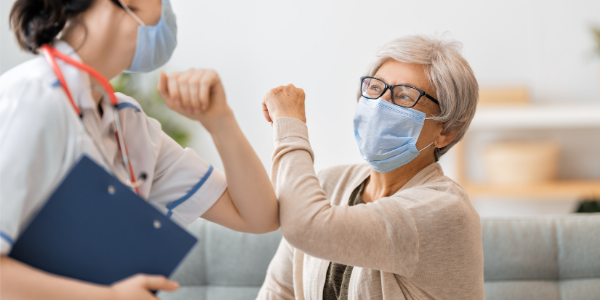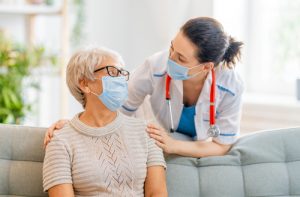One thing we have learned about COVID-19 is that seniors in care facilities face the highest risks, but they can stay safer by following these steps.
What Are the Risks of Contracting COVID-19 for Nursing Home Residents?
Since the COVID-19 virus appeared in the U.S. in February of last year, the biggest concern for our society has been how the elderly are affected. As seniors already have compromised immune systems, it stands to reason that they face greater risks of contracting the disease and of suffering the worst effects of the disease. Data has been analyzed over the past 12 months, and, as a result, we have learned that 40% of COVID-19 deaths have occurred in assisted living facilities. This is especially alarming considering that residents in those facilities only comprise 1% of our country’s total population.
By looking at one specific facility, the Life Care Center of Kirkland, it becomes easier to put those statistics into context. That facility has 108 residents and 180 employees. While the facility has been regarded by federal agencies to have a five-star rating, their high quality of care wasn’t enough to protect everyone from COVID-19. It was reported that 27 residents and 25 staff members exhibited signs of the virus early last year.
By June, Life Care Center of Kirkland was just one of many facilities showing signs that nursing home residents and employees faced an exceptionally high risk. Of 9,912 facilities examined in the survey, it was discovered that 264,000 people had exhibited signs of having contracted COVID-19. Of those residents and employees, 54,000 individuals had died as a result of contracting the virus. Since Thanks Giving, the latest counts found that nearly 100,000 nursing home residents and employees had suffered COVID-related deaths.
 What Can Seniors in Care Facilities Do to Protect Themselves?
What Can Seniors in Care Facilities Do to Protect Themselves?
While the risk for contracting COVID-19 is definitely higher in care facilities, this knowledge provides us with the motivation to make these environments safer. It ensures residents and staff will be especially diligent in protecting themselves and others. By adhering to the following health and safety practices in an assisted living facility, you can keep yourself and others better protected from spreading harmful bacteria and viruses. In addition to slowing the spread of COVID-19, these practices can also help guard against the spread of other illnesses, such as the flu and the common cold.
While residents don’t have to wear masks when alone in their rooms, they should wear masks anytime they enter common areas in the facility. Additionally, masks should be worn when interacting with other residents, staff members or visitors.
As a general practice, interactions with others should be limited. When it is necessary to engage in conversation with others in the home, the six-foot distancing rule should be applied. Social interactions are best conducted outdoors to reduce the risks of infection.
Each resident and staff member should have a bottle of hand sanitizer that contains a minimum of 60% alcohol to ensure the skin is properly disinfected. Everyone should be encouraged to sanitize their hands as frequently as possible. In particular, hands should be sanitized immediately after touching surfaces in common areas.
While touching your face may be an involuntary act, it’s important to make yourself consciously aware of this habit. Before and after touching your face, you should use hand sanitizer to protect against transmitting viruses from your hands. Additionally, the mouth should be covered with the arm or crook in the elbow when coughing and sneezing. This prevents you from spreading bacteria and germs to your hands.
If your local grocery store has senior hours, it’s best to shop during those times. Otherwise, try to shop when the store is least populated. This will reduce the risks of exposure that interaction with large groups presents.
Whether you’re a resident or a care facility employee, you should report any symptoms to the facility’s managers and to your personal caregiver. If you’re an employee, you should begin quarantining at home immediately. If you’re a resident in an assisted living facility, you should remain in your room until the staff can examine you. Taking these precautions will help limit the spread of the virus so your risks will be limited when you do return to your normal routine.

 What Can Seniors in Care Facilities Do to Protect Themselves?
What Can Seniors in Care Facilities Do to Protect Themselves?



